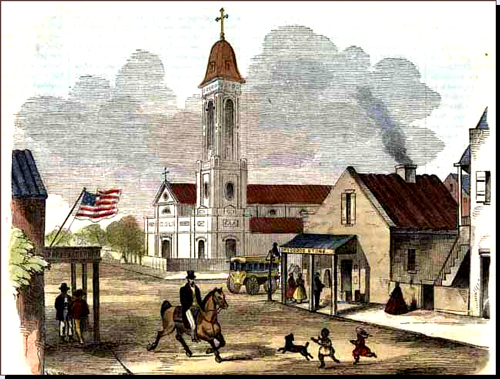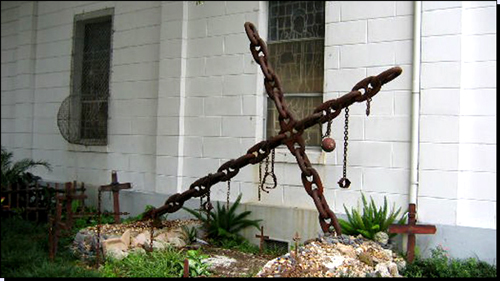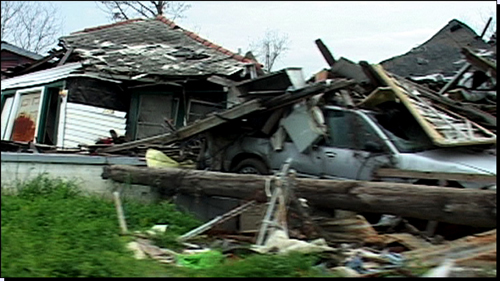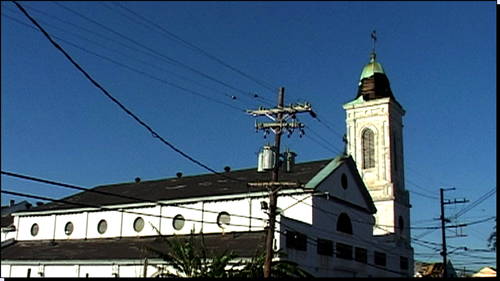Background
History of St. Augustine Church
St. Augustine Church, built by free black people with slave labour in 1841, was the first place of worship where slaves, free people of color and whites sat side by side in prayer. It is a highly significant symbol for the African-American community in America.

Saint Augustine church - New Orleans, Louisiana, 1870
The grounds now include a monument called "The Tomb of the Unknown Slave". Open shackles and a ball and chain hang from a cross. A rope symbolizing a lynching hangs from a tree limb. Bones of slaves are said to be buried on the premises.

The Tomb of the Unknown Slave
Many people consider the church to be the cradle of jazz. Slaves and free people of color would pray and sing in the church. After Sunday mass they would continue singing and dancing in nearby Congo Square. There they fashioned a sound that would uniquely characterize New Orleans.
Hurricane Katrina
On August 29, 2005, Hurricane Katrina slammed into the southern coast of the United States. It was perhaps the single most devastating natural disaster ever to hit the country. Over a thousand people died and hundreds of thousands were displaced by the storm. Today more than half of the inhabitants of New Orleans - mostly African-Americans - are still in exile with no obvious way home.

Property destroyed by Hurricane Katrina
Father LeDoux stayed in the Tremé neighbourhood for eight days after the hurricane so he could watch over the church and his neighbours, giving them spiritual solace and first aid. Many St. Augustine parishioners lost family members and their homes were destroyed.
Though St. Augustine was damaged by the storm, the flood waters hardly reached the sidewalk around the church. It is a very valuable piece of property indeed.
History of the Conflict
Six months after Hurricane Katrina struck New Orleans, Archbishop Alfred Hughes announced that he would close the parish of St. Augustine Church and dismiss its priest, Father Jerome LeDoux. The archdiocese said it could no longer afford to subsidize the church as many of its places of worship were damaged by the hurricane. There are far fewer parishioners now and, according to the archdiocese, the funds are lacking to repair church property.
The people of St. Augustine were dumbfounded. It is true that Hurricane Katrina ripped the metal sheeting off the church's steeple and opened its roof sufficiently to create at least $400,000 in rainwater damage. But several other churches were more badly damaged and nevertheless remain open.

St Augutine church steeple damaged by the hurricane
The archdiocese has stated several reasons for closing the parish - few registered members, no school, no programme for people interested in converting to Catholicism, inadequate management of administrative affairs and poor record-keeping.
St. Augustine is a poor parish and owes money to the archdiocese. Most of the African-Americans from New Orleans remain scattered throughout the United States as they simply have no homes to come back to. Obviously attendance at the church has dropped following the storm. As a result, funds collected from the parishioners - and therefore their contribution to the archdiocese - have plummeted.

Reporters interviewing parishioner, Cecelia Galle
After the archbishop's announcement, parishioners expressed their doubts and confusion. St. Augustine is providing food, clothing and spiritual aid. Why close their parish now when the community is on its knees, struggling to recover and rebuild after the hurricane? Parishioners suspect the archdiocese has other reasons from those it proclaims. Father Jerome LeDoux is known for his unconditional acceptance of the poorest and neediest of the community, whether they are Catholic or not. The archdiocese has begun reparations on St. Augustine and people suspect that they want to turn it into a museum, realizing what a rich historical gem it is. The church is located near the famous French Quarter of New Orleans and the closure is seen as part of a plan to upgrade the neighbourhood.